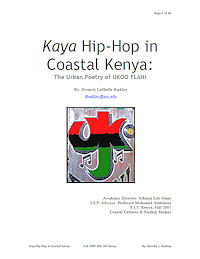> Kenya | Books | Articles |
See as well / Voir aussi / Veja também “East Africa general – Books”
Barkley, Divinity LaShelle:
Kaya Hip-Hop in Coastal Kenya: The Urban Poetry of Ukoo Flani.
University of Southern California (Los Angeles).
Independent Study Project (ISP) Collection. Paper 125, 2007. 46 p.
Contents – PDF Download / Télécharger / Baixar 264 KB
Chiuri, J. G.:
Pop Music is a Form of Oral Literature: A Survey on Joseph Kamaru.
P.G.D.E. Thesis. University of Nairobi, 1984.
Eisenberg, Andrew J.:
The Resonance of Place: Vocalizing Swahili Ethnicity in Mombasa, Kenya.
Ph.D. Columbia University (New York, N.Y.), 2009: 472 p.
ProQuest no. 3388445
Eagleson, Ian M.:
From Thum to Benga International:
Continuity and Change in the Music of the Luo of Kenya, 1950-2010.
Ph.D. Wesleyan University (Middletown, Conn.), 2012. 744 p.
ProQuest no. 3519894
Gitonga, Priscilla Nyawira:
Music as Social Discourse: The Contribution of Popular Music to
the Awareness and Prevention of HIV/AIDS in Nairobi, Kenya.
M.M. Nelson Mandela Metropolitan University (Port Elizabeth), 2009. 238 p.
Contents – PDF Download / Télécharger / Baixar 1.89 MB
King’ei, Geoffrey Kitula:
Language, Culture and Communication:
The Role of Swahili Taarab Songs in Kenya, 1963-1990.
Ph.D. Howard University (Washington, D.C.), 1992. vii & 240 p.
Contents – PDF Download / Télécharger / Baixar 6.39 MB
Maina wa Mũtonya:
The Politics of Everyday Life in Gĩkũyũ Popular Music of Kenya (1990-2000).
Ph.D. University of the Witwatersrand (Johannesburg), 2006.
Maina wa Mũtonya:
The Politics of Everyday Life in Gĩkũyũ Popular Music of Kenya.
Nairobi: Twaweza Communications Ltd., 2013. 172 p.
Contents
Milu, Esther:
“Hatucheki Na Watu”:
Kenyan Hip-Hop Artists’ Theories of Multilingualism, Identity and Decoloniality.
Ph.D. Michigan State University (East Lansing, Mich.), 2016, xii & 195 p.
Contents – PDF Download / Télécharger / Baixar 2.88 MB
Ministry of State for National Heritage and Culture:
Music Policy.
[Nairobi]: June 2012. 41 p.
Contents – PDF Download / Télécharger / Baixar 396 KB
Morin, Matthew McNamara:
Composing Civil Society:
Ethnographic Contingency, NGO Culture, and Music Production in Nairobi, Kenya.
Ph.D. Florida State University (Tallahassee, Fla.), 2012. xxi & 329 p.
Contents – PDF Download / Télécharger / Baixar 5.37 MB
Mwaniki, J. K. (ed.):
Kakai Kilonzo with Kilimambogo Brothers.
Nairobi: Audio Productions Ltd., n.d. [c.1987] 38 p.
Contents
Ngige-Nguo, Josiah Edward:
The Role of Music amongst the Gikuyu of the Central Province of Kenya.
Ph.D. Queen’s University of Belfast, 1990. 676 p.
ISNI no. 0000 0001 3445 1895
Njenga, Maureen Charity Muthoni :
Mũgithi Perfomance as a Form of Social Cohesion among the Agĩkũyũ of Kenya.
M.M. University of KwaZulu-Natal (Durban), 2010. ix & 140 p.
Contents – PDF Download / Télécharger / Baixar 2.79 MB
Nkonge , M.K.:
A Literary Study of the Songs of Joseph Kamaru: Theme and Style.
B.E.D. Thesis. Kenyatta University (Nairobi), 1988.
Ntarangwi, Mwenda G.:
Taarab Texts, Gender, and Islam in an Urban East African Context:
Social Transformations among the Waswahili of Mombasa, Kenya.
Ph.D. University of Illinois at Urbana-Champaign, 1998. 359 p.
ProQuest no. 9904550
Ntarangwi, Mwenda:
The Street Is My Pulpit. Hip Hop and Christianity in Kenya.
Champaign, Ill.: University of Illinois Press, 2016, 206 p.
Contents
Nyairo, Joyce Wambũi:
“Reading the Referents”. (Inter) Textuality in Contemporary Kenyan Popular Music.
Ph.D. University of the Witwatersrand (Johannesburg), 2004. xxix & 283 p.
Contents – PDF Download / Télécharger / Baixar 2.88 MB
Okumu, Caleb Chrispo:
The Development of Kenyan Popular Guitar Music:
A Study of Kiswahili Songs in Nairobi.
M.A. Kenyatta University (Nairobi), 1998.
Omolo-Ongati, Rose Anyango (ed.):
A Biography of Kenyan Musicians, Vol. 1.
Nairobi: Permanent Presidential Music Commission, 2010. vii & 197 p.
ISBN 978-9966-21-025-8
Osusa, Tabu & Bill Odidi (eds.):
Retracing the Benga Rhythm.
Nairobi: Ketebul Music, 2008. 23 p. CD & DVD
Contents
Osusa, Tabu & Bill Odidi (eds.):
Retracing Kikuyu Popular Music.
Nairobi: Ketebul Music, 2010. 77 p. CD & DVD
Contents
Osusa, Tabu & Bill Odidi (eds.):
Retracing Kenya’s Funky Hits. Afro Boogie of the 70s & 80s.
Nairobi: Ketebul Music, 2011. 85 p. CD & DVD
Contents
Osusa, Tabu & Bill Odidi (eds.):
Retracing Kenya’s Songs of Protest.
Music as a Force for Change in Kenya: 1963-2013.
Nairobi: Ketebul Music, 2013. 105 p. CD & DVD
Contents
Osusa, Tabu & Bill Odidi (eds.):
Shades of Benga – The Story of Popular Music in Kenya: 1946 – 2016.
Nairobi: Ketebul Music, 2017. xxi & 649 p.
Contents
Otoyo, Donald & Emily Achieng Akuno:
Kenyan Musicians. A Biography. Volume 2.
Nairobi: Permanent Presidential Music Commission, 2018.
Owen, Caleb Edwin:
It was Just for Fun:
Taarab and the Construction of Community Identity in Two Kenyan Towns.
B.A. University of Oregon (Eugene, Oreg.), 2010. vi & 101 p.
Contents – PDF Download / Télécharger / Baixar 1.55 MB
Salm, Steven James:
Sitting Here in Limbo: Popular Music and Identity Transformation
among the Disenfranchised Youth of Freetown and Nairobi.
M.A. University of Texas at Austin, 1997.
Wallis, Roger & Krister Malm:
Big Sounds from Small Peoples.
The Music Industry in Small Countries.
London: Constable, 1984. 419 p.
Case study including Kenya
Kenya Index
Wambua, S. M.:
Mtindo wa nyimbo za Kaikai Kilonzo.
M.A. Kenyatta University (Nairobi), 2001.
Wanguhu, Michael (Producer/Director) & Written by Russell Kenya:
“Hip-Hop Colony” The African Hip-Hop Explosion.
Oakland Calif.: Emerge Media Films, 2007. 92 minutes DVD
ASIN no. B000MRA57E
Wetaba, Aggrey Nganyi R.:
Kenyan Hip-Hop as a Site of Negotiating Urban Youth Identities in Nairobi.
Ph.D. Johannes Gutenberg-Universität (Mainz). Göttingen: Sierke Verlag, 2009. 450 p.
Contents
Page created 23/09/2017 © afrobib.com – update 26/10/2019

 CONTENTS
CONTENTS CONTENTS
CONTENTS CONTENTS
CONTENTS CONTENTS
CONTENTS CONTENTS
CONTENTS CONTENTS
CONTENTS CONTENTS
CONTENTS CONTENTS
CONTENTS CONTENTS
CONTENTS CONTENTS
CONTENTS CONTENTS
CONTENTS CONTENTS
CONTENTS CONTENTS
CONTENTS CONTENTS
CONTENTS CONTENTS
CONTENTS CONTENTS
CONTENTS CONTENTS
CONTENTS
 CONTENTS
CONTENTS
 CONTENTS
CONTENTS CONTENTS
CONTENTS INHALT (Button Type)
INHALT (Button Type) CONTENTS
CONTENTS